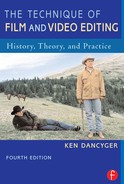INTRODUCTION TO THE FOURTH EDITION
The Technique of Film and Video Editing was first published in 1993. Much has changed as addressed in the second and third editions. With this fourth edition it's opportune to acknowledge all the changes since 1993.
First we need to acknowledge the digital revolution. Technology has transformed the technology of editing, the speed of editing and conceptually the aesthetics of editing. Both in production and post-production, the digital revolution has had a profound impact on sound and image. The goal of these two phases as well as pre-production is storytelling. Has the digital changes influenced storytelling? This is a primary issue in editions two through four.
A second issue that needs to be acknowledged is that this book has increasingly become a history of editing. It didn't start out that way. It began as a book intended to be helpful to directors. But as change accelerates, the need to be reminded where the changes came from has grown stronger. The seminal moments in the history of editing, Hitchcock's Blackmail, (1929), Welles’ Citizen Kane (1941), Kurosawa's Rashomon (1951), Resnais’ Hiroshima, Mon Amour (1960), Godard's Breathless (1959) and Fellini's 8½ (1963) have grown in importance.
New issues included in the second and third editions are the evolution of the MTV style and nonlinear editing. Both address these new issues. Another issue addressed in the third and now in the fourth edition is the number of phenomenological issues has entered the editing arena. In a digital age when an image can be amended, altered to look real, what is real and what is unreal? What reality determines editing choices? The documentary film increasingly has flirted with entertainment values just as the dramatic film has flirted with documentary values. When educational forms and entertainment forms adapt the values of the other, how does this influence editing choice? And in a world where novelty has become a value rather than a passing observation, how does this affect editing choices. The new chapters on long shots and close shots, sound, pace and the changes in documentary discuss these issues.
Much changes and nothing changes. History is a continuum and editing is informed by that history. I'm please that the subtitle of this book is now “History, Theory and Practice.” That is my purpose in writing this fourth edition.
